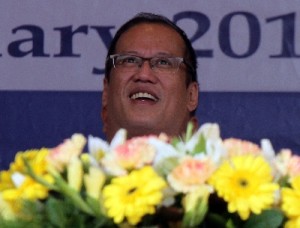8 PPP projects to be bid out this year—Aquino
President Aquino on Tuesday said his 21-month-old administration would redouble its efforts on the economic front, vowing to bid out to the private sector more big-ticket infrastructure projects meant to help grow the economy faster.
The President’s commitment to fast-track the rollout of his flagship Public Private Partnership (PPP) program came amid concerns that the Philippine economy would be dampened this year due to a resurgence of the high cost of crude oil that could push pump prices higher and crimp growth.
“For this year, we are looking at rolling out about eight projects,” he told local and foreign investors during Tuesday’s Euromoney Philippine Investment Forum at the Manila Peninsula Hotel in Makati City.
“For this year, we’re excited about the PPP program for school infrastructure, and the airports,” he said, addressing questions from the forum’s moderator. He noted that the country’s premier airport, the Ninoy Aquino International Airport (NAIA), was now approaching “saturation point” and that there was a real need to expand the country’s international gateways.
The government has yet to decide on the future development of the country’s international gateways, whether NAIA’s terminals would be expanded or to shift focus fully to the Diosdado Macapagal International Airport in Clark, Pampanga.
Article continues after this advertisementAquino also told investors that his administration was now studying the revival of the nautical highway system—a concept pioneered by the administration of former President Gloria Macapagal-Arroyo as the Ro-Ro system.
Article continues after this advertisementThe President said that the present variant being studied has the ability to cut land travel time between Luzon and Mindanao from the present three days to only 15 hours. This, he said, would be a boon to food producers in Mindanao who would then be able to ship their products to markets in Luzon faster and at lower costs.
President Aquino also acknowledged that his administration—criticized heavily for its seeming lack of a sense of urgency in implementing the PPP program—has to work faster on the approval process for various infrastructure projects that would be offered to private sector investors.
“There has to be a more speedy thumbs up or thumbs down for all the projects that are under consideration,” he said, adding that the country could not afford to take its time in implementing growth-inducing infrastructure deals as opportunities that were missed because of these delays.
Nonetheless, the President noted that there was now growing interest in the country from investors.
He cited, as an example, the plan to connect the North Luzon Expressway to the South Luzon Expressway via an elevated highway that would cut through Metro Manila.
In the past, he explained that the government had to sweeten offers to private investors just so they would express interest in bidding for projects.
“Very attractive terms for investors just to attract people. Now, however, a project like the NLEx-SLEx (connector road) don’t just have one proponent, they have two proponents,” he said, referring to rivals San Miguel Corp. and the Metro Pacific group, both of which have submitted proposals. “Studies are indicating that both can happen simultaneously.”
“Before there were no takers, now we have so many takers,” the President said.
In his speech, President Aquino said the government planned to invest this year in three sectors—agriculture, tourism and infrastructure, which he stressed would “have the largest impact in our economy and in the lives of our people” as this would also create more jobs in the country.
